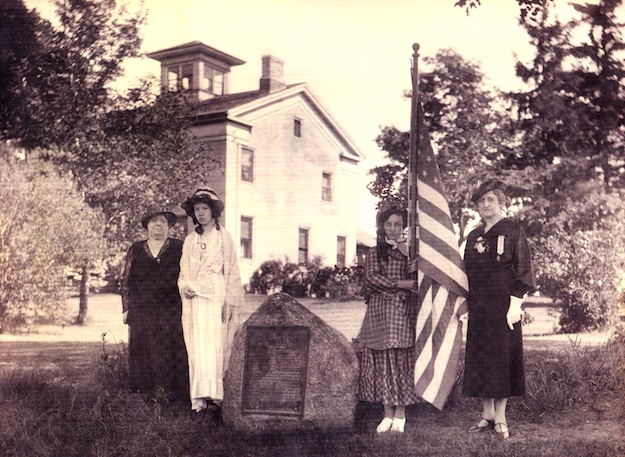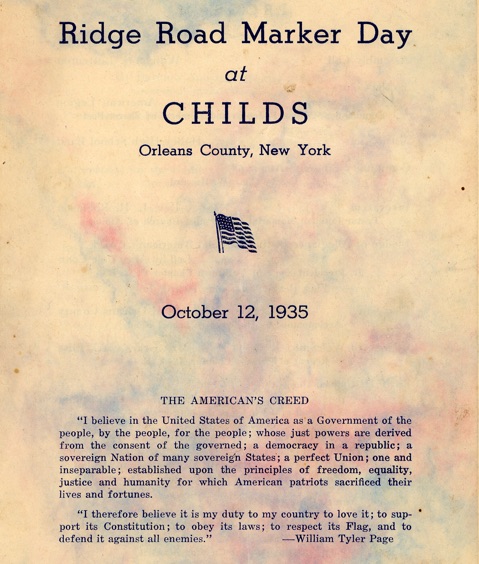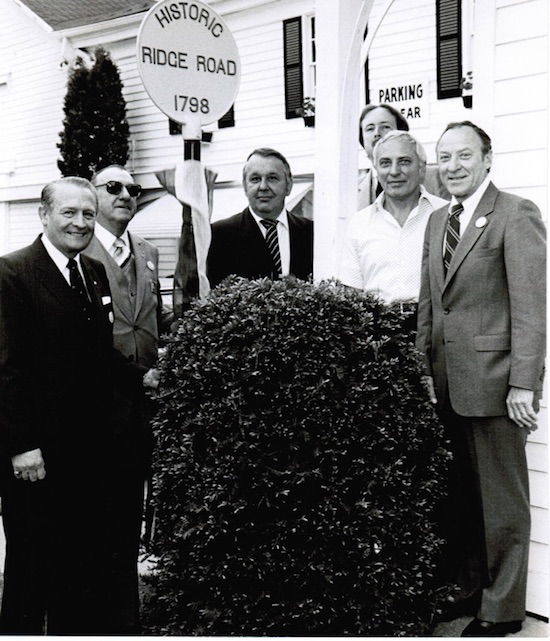DAR placed 5 historic markers in Gaines on Ridge in 1930s
Local group didn’t like sentimental name of ‘Honeymoon Trail’
By Adrienne Kirby, Gaines Town Historian

This photo was taken at the corner of Ridge Road and Rt. 279, or Gaines Road, looking south. At this point, the Ridge was paved, since the curb is just visible at the bottom of the photo. Folks traveling to Albion still had to travel a dirt road.
GAINES – With the rise of the automobile in the 1920’s, roads throughout Western New York were slowly improved. Ridge Road was first paved through Gaines in 1926.
On Aug. 26, Gaines held a Booster Day celebration with a parade to commemorate the completion of the improvements made to its geographical main artery. Paving the road brought about significant business opportunities, which were seized upon almost immediately.
Less than a year later, in June of 1927, the Medina Daily Journal published a rather bemused editorial reporting signs painted on telephone or telegraph poles of “two bleeding hearts pierced by an arrow which is supposed to designate ‘Honeymoon Trail.’”
The origin of the signs was a mystery at the time of publication. Though Ridge Road does end at Niagara Falls, often called the Honeymoon Capital of the World, the editors at the Journal were not impressed and suggested “Ground Hog Road” or “Green Frog Trail” as alternate titles. They concluded “The Old Ridge Road” would be a more respectable name.
The D.A.R. was in full agreement, and used everything in their arsenal to prevent such a “sentimental title” from taking root in the public mind. Just a month later, as reported by the Journal, the Orleans Chapter of the D.A.R. were “up in arms” over the proposed change of name and passed a resolution expressing their disapproval.
The committee responsible for drafting resolutions to preserve the historic nature of Ridge Road was chaired by Katherine Rowley, Orleans County’s first historian and a citizen of Gaines. They proposed that the new name was “insignificant and unworthy”, that “the majority of citizen[s’] … sense of propriety has been violated by such change of name,” and that “the name of ‘The Ridge Road’ should endure forever…”
By April 1928, the D.A.R. was fully mobilized and the Orleans Chapter had proposed working with the Monroe and Irondequoit Chapters to place “neat blue and white markers which are to carry the title ‘The Historic Ridge Road, established in 1798.’” They were to be 14 inches in diameter and placed every five miles through Orleans and Monroe counties. In addition, plans were being made to involve the State Historical Monuments Society in the “movement.”
The proposals were successfully implemented. Between 1930 and 1935, the D.A.R. placed five markers in Gaines, along with others in the towns of Ridgeway and Murray, thanks to legislation New York State passed in 1923 anticipating the sesquicentennial of the American Revolution in 1926. The Department of Education was to work with local groups to erect “markers to designate sites that are of historic significance in the colonial, revolutionary or state formative period…” among other efforts to commemorate the national celebration.
Curiously enough, the Orleans Chapter has no records of putting up “The Historic Ridge Road” markers, and yet a sign which closely matches the description in the newspaper stands next to the Village Inn at Childs.

The above photo shows Katherine Rowley on the far left on the day of the dedication of the marker, on Oct. 12, 1935. This is most likely the last known photo of her, as she passed away three days later. Next to Miss Rowley is Barbara Balcom, and the girl holding the flag is Elda Barnum, both great great grand nieces of John Proctor. The woman wearing gloves is Grace Bliss, then Regent of the Orleans Chapter, D.A.R. The observant local reader will notice that in the photograph of the marker, the west side of the Proctor House is visible, and yet today, the marker is on the east side of the property. About fifteen years ago, the marker was moved in order to make it more visible to the public, as it was somewhat hidden by the hedgerow and low branches of the large black maple which sits in the northwest corner of the yard.

The program for the dedication of the Proctor Marker, printed on a patriotic-looking red, white and blue mottled paper.

This photo was taken on May 22, 1983 for the dedication of the historic marker at the Village Inn as part of the kick-off for the Gaines Jubilee, celebrating the 175th anniversary of the Town of Gaines. Pictured from left to right are Ernest Leonardi, Masonic Grand Master of New York; Charles Aldrich, Niagara Orleans District Masonic Deputy Grand Master; Ronald Radzinski, Gaines Supervisor; C.W. Lattin, Curator of Cobblestone Museum; William Tillman, Proprietor of the Village Inn; and R. Stephen Hawley, New York State Assemblyman.







































































